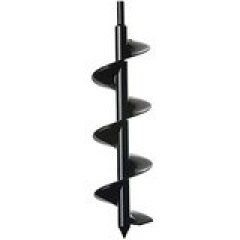Buying guide for Best augers
Digging even a single hole in the ground by hand can cause a great deal of wear and tear on your hands, arms, shoulders, and especially your back. Each additional hole that you dig increases the likelihood of pain or injury. If you have several holes to dig, it's time to consider an auger.
Think of an auger as a drill for dirt or ice. Augers come in a variety of types and sizes so you can accomplish a wide variety of tasks ranging from planting flowers to putting up a fence. Augers can be powered manually, but chances are good that if you need an auger, it probably means you should be considering at least an electric model and possibly a gas-powered tool. The best augers are heavy duty and come with a warranty the shows the manufacturer has faith in the product.
To help you determine the best auger type for your individual needs, keep reading our guide. If you're ready to buy now, consider one of the highly rated options listed in this article.
Key considerations
Before you purchase an auger, you need to determine how you will be using it. An auger that is great at digging holes for fence posts will be overkill if you're just looking to plant a few flower bulbs. Conversely, getting a manual auger is something you may regret when you're digging your 30th fence-post hole. In order to get precisely what you need, consider the following.
Manual vs. power
If you only need to dig a few holes and this is not a task you will be performing regularly, it might be in your best interest to go with manual equipment. You can get an auger that you twist by hand, or even a post digger, if the job isn't too big. Purchasing a pricey power tool that you only use one weekend over the next five years may not be the wisest use of money.
Hole size
What is the diameter and depth of the average hole that you will need to dig? Most auger bits come very clearly labeled and will tell you how long the auger is and the diameter of the hole that it drills. For instance, a 28-inch-long auger bit that is 2 inches in diameter would slip into a handheld power drill and be ideal for planting bulbs.
Power drill vs. powerhead
A powerhead is the motor that drives your auger bit. Smaller-sized auger bits, two or three inches in diameter, fit into a handheld power drill. If you need to make holes that are larger in diameter, four inches and up, you will need a dedicated powerhead – unless you are digging the holes manually.
Material drilled
Are you drilling through soil or ice? An earth auger and an ice auger are not built the same. If you have a unique situation, make sure the model that you are considering is up to the task.
Features
Once you have determined what work you will be doing and you understand the type of tool you need, then you can consider some of the options that you have.
Manual, electric, or gas
A manual auger means you do the work by hand. These are the best choice for working in loose soil and when you do not have a lot of holes to dig. An electric auger can be corded or powered by a battery. Depending on battery life, either is a decent option for digging numerous holes in soil that isn't too tough. Remember that with a corded model, your range is limited. Gas-powered augers are what you want for heavy-duty work. If you’re digging in hard-packed clay or rocky soil, this is your best option.
One- or two-person operation
If you plan on working alone, you will need to purchase a one-person auger. These machines are lighter weight, usually under 40 pounds, and they are best for small and medium-sized projects. A two-person auger can easily weigh 70 pounds. These models must be operated with assistance, but they are able to handle the toughest jobs.
Handle
The handle could be the most overlooked feature on an auger. For a manual auger, you want something ergonomic that will be easy to hold, producing the least possible amount of muscle strain. A powered auger needs a sturdy handle so you can hold tight while whirling through rocks and roots. A handle that is loose or not easily gripped can be dangerous in heavy-duty situations.
Bit sizes
As noted previously, choosing the proper size bit is essential. Consider the size of the holes you need to dig, both depth and diameter, to be sure the auger you are purchasing is appropriate for the job.
Caution
When working on an uneven surface or an incline, enlist some help. If you are fighting for balance, not only is that a dangerous situation, but there's a good chance your hole will not be straight.
STAFF
BestReviews
Auger prices
The word auger can encompass a wide variety of tools, from small wood drill bits to large gas-powered machines operated by two people that dig holes in the ground. For the purpose of this price guide, we will focus on earth augers.
Inexpensive
For $20 to $70, you're mostly going to find auger bits that are designed for smaller jobs such as planting bulbs and root aeration. In general, these will work with a handheld power drill.
Mid-range
In the $70 to $160 price range, the bits you will find are larger and designed to dig holes for fence posts. These bits are manufactured for use with a one- or two-person powerhead. Additionally, you can find a manual auger that looks like a long T and requires the user to twist the tool into the ground by hand.
Expensive
When you get to the $170 to $300 range, you're looking at equipment with a dedicated powerhead. These can either be powered by gas or electricity and require one or two users.
Safety tips
As with any power tool, safety should be your primary concern. Following are a few tips to help prevent accidents and lessen the chance of injury when using augers.
- Before digging anything more substantial than gardening holes, call 811. That’s not just a suggestion, it's the law. Calling 811 a few days before you begin work gives the local utility companies time to mark any underground pipes and wires so you are certain that it is safe to dig.
- If you've buried anything underground, such as sprinkler lines, be certain you know exactly where those things are before digging.
- Read the entire owner's manual, and follow all recommended safety precautions.
- Wear adequate protection. Because an auger can whirl dirt and rocks at high speeds, you will need sturdy shoes, long pants, and eye protection. It is also important to wear gloves and have hearing protection as well.
- Never wear loose clothing or jewelry while operating an auger.
- Always turn off the auger before removing it from the hole.
- Be prepared for the unexpected. A thick root can bring your auger to an abrupt stop, so never let your guard down while working.
- It is safer to run the auger at slower speeds whenever possible.
- Keep up with maintenance for your auger. A clean, well-functioning machine is a safe machine.
- Cover any open holes to protect yourself and others (including pets and animals) from injury.
FAQ
Q. What exactly is an auger?
A. To get a good visual, think of an auger as a dirt drill. When you need to make a hole in your landscape, whether planting bulbs or putting up a fence, an auger is the tool to use.
Q. I have a shovel and a post-hole digger, why do I need an auger?
A. Actually, if you do not do a lot of yard work, you might not need an auger. But hole digging can be strenuous work, and if you’re doing it repetitively, an auger is a nice tool to have, especially since it allows you to remain upright, which can greatly reduce back strain.
Q. How do I know which bit to use with my auger?
A. In most instances, you only need two pieces of information to find the best bit for your needs: the diameter and the depth of the whole that is being drilled. There are some instances where the material you will be drilling through will require more specific equipment. For example, if you need to drill through ice for ice fishing, you will not be able to use an earth auger because the bit won't be sharp enough and the machine may not function well in extremely cold temperatures.
























